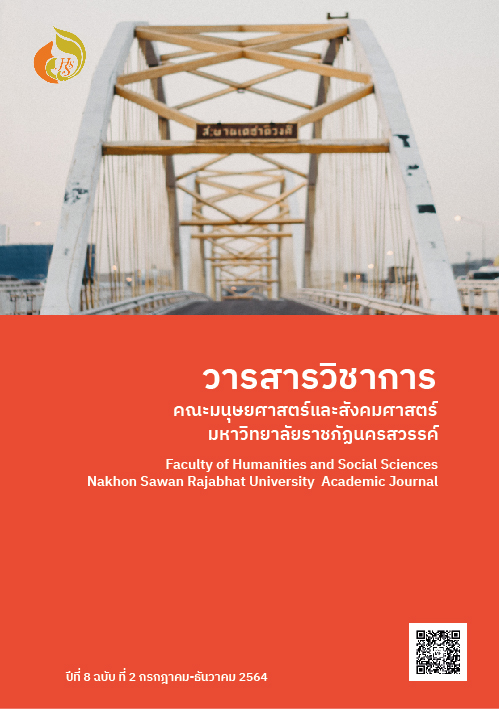Buddhism in China
Main Article Content
Abstract
This academic article aims to say the history and origins of Buddhism in China. Chinese Buddhism patterns and the role of Buddhism in China today by collecting data from research papers, books, journals and articles to analyze, process and summarize content for the purposes set out above. This is expected to be beneficial to the study of Chinese culture, especially to those interested in the cultural beliefs of the Chinese people.
The result of the study found that Buddhism entered China in the Han Dynasty and the first Buddhist temple was built in China. Later, the Tang Dynasty was considered the most prosperous era of Buddhism in China because the emperor has the corrupt faith in Buddhism. So, he patronized Buddhism and sent monks to India and brought the Tripitaka back to China and there have been many translations of the Sutra from Pali into Chinese. After that, Buddhism gradually deteriorated until in the Qing Dynasty, the king would pay more attention to Tibetan Vajrayana Buddhism until the Cultural Revolution of President Mao Zedong, many temples and scriptures were burned down because religious beliefs and cults were considered a threat to the Chinese Communist Party. It is considered the depressing era of Buddhism in China. After that, in the era of President Deng Xiaoping, this rule was loosened, thus making Buddhism in China more attractive to the outside world and developed to become the Chinese Buddhism that we have seen today.
Article Details

This work is licensed under a Creative Commons Attribution-NonCommercial-NoDerivatives 4.0 International License.
References
กองคลัง มหาวิทยาลัยหัวเฉียวเฉลิมพระเกียรติ. (2560). พระพุทธศาสนาบนแผ่นดินจีน. สืบค้นเมื่อวันที่ 5 มีนาคม 2564, จาก http://finance.hcu.ac.th/?p=3116
ชิว ซูหลุน. (2555). วิวัฒนาการของพุทธศาสนาในจีน. สืบค้นเมื่อวันที่ 20 มีนาคม 2564, จาก
http://thai.cri.cn/441/2012/04/19/242s197058.htm
ทริปเดินทาง. (2559). ถ้ำมั่วเกาแห่งตุนหวง敦煌莫高窟:dunhuangmogaoku. สืบค้นเมื่อวันที่ 12 มีนาคม 2564, จาก
https://tripderntang.com/ถ้ำมั่วเกาแห่งตุนหวง
นิธิพันธ์ วิประวิทย์. (2559). พระถังซัมจั๋ง นักเรียนนอกผู้ยิ่งใหญ่. สืบค้นเมื่อวันที่ 15 มีนาคม 2564, จาก
https://www.posttoday.com/life/healthy/410699
บุณฑริกา นารี. (2563). พุทธศาสนามหายานบนแผ่นดินจีน. สืบค้นเมื่อวันที่ 20 มีนาคม 2564, จาก
https://www.arsomsiam.com/พุทธศาสนามหายานในจีน
ปริวัฒน์ จันทร. (2562). “พุทธศาสนา” บนเส้นทางสายแพรไหมจาก “อินเดีย” สู่ “จีนกลาง”. สืบค้นเมื่อวันที่ 3 มีนาคม 2564, จาก https://www.silpa-mag.com/history/article_15085
พระศรีคัมภีรญาณ (สมจินต์ สมฺมาปญฺโญ, ป.ธ.๙). (2559). พระพุทธศาสนาในประเทศจีน. สืบค้นเมื่อวันที่ 8 มีนาคม 2564, จาก https://panyadham.wordpress.com/2016/08/24/
พระสร้อย ชยานันโท. (2564). พุทธศาสนานิกายมหายาน. สืบค้นเมื่อวันที่ 20 มีนาคม 2564, จาก
http://riwochecenter.org/mahayanateaching/
วชิรปาณี. (2551). พระวชิรปาณีโพธิสัตว์. สืบค้นเมื่อวันที่ 12 มีนาคม 2564, จาก
http://oknation.nationtv.tv/blog/wachirapani/2008/10/17/entry-6
เศรษฐพงษ์ จงสงวน. (2562). พุทธศาสนามหายาน. ค้นเมื่อวันที่ 20 มีนาคม 2564, จาก https://www.arsomsiam.com/
เศรษฐพงษ์ จงสงวน
สมเด็จพุทธโฆษาจารย์ (ป.อ. ปยุตโต). (2515). พระพุทธศาสนาในเอเชีย. สืบค้นเมื่อวันที่ 5 มีนาคม 2564, จากhttps://www.payutto.net/book-content/ ๓-พุทธศาสนาในจีน
เสถียรพงษ์ วรรณปก. (2561). พระถังซัมจั๋ง. สืบค้นเมื่อวันที่ 1 มีนาคม 2564, จาก
https://www.matichon.co.th/columnists/news_990356
เหล่าตั๊ง. (2556) พุทธศาสนาแบบจีน. จดหมายข่าวอาศรมสยาม-จีนวิทยา ฉบับประวัติศาสตร์และวัฒนธรรม.
ฉบับที่131-134
China Xinhua News. (2561). จีนให้เสรีภาพด้านการนับถือศาสนา. สืบค้นเมื่อวันที่ 20 มีนาคม 2564, จาก
https://www.facebook.com/XinhuaNewsAgency.th/posts/2065752496974095/
jiewfudao. (2554). 普贤菩萨พระสมันตภัทรโพธิสัตว์. สืบค้นเมื่อวันที่ 12 มีนาคม 2564, จาก
https://www.duitang.com/album/?id=77432777
Kelly Pang. (2564). Buddhism in China — Ancient History to Beliefs Today. สืบค้นเมื่อวันที่ 1 มีนาคม 2564, จาก https://www.chinahighlights.com/travelguide/buddhism.htm .
Plookpedia. (2560). สถาปัตยกรรมวัดจีน. สืบค้นเมื่อวันที่ 20 มีนาคม 2564, จาก
https://www.cpmeiji.com/meijitensai/content/detail/60287/60280
xiaotutu. (2562). 佛.สืบค้นเมื่อวันที่ 12 มีนาคม 2564, จาก https://www.duitang.com/album/?id=77432777
中华人民共和国中央人民政府.(2556). 中国佛教历史及其主要派别 .
สืบค้นเมื่อวันที่ 9 มีนาคม 2564, จาก http://www.gov.cn/test/2005-06/22/content_8448.htm
中国佛教协会.(2558-2563). 中国佛教文化研究所发展规划.สืบค้นเมื่อวันที่ 9 มีนาคม 2564, จาก http://www.chinabuddhism.com.cn/yj/2016-02-26/10337.html.
梁启超 (2551). 中国佛教研究史. 中国社会科学出版社. pp. 2- 58.
法忍法师.(2563). 大乘佛教的目标与实践. สืบค้นเมื่อวันที่ 5 มีนาคม 2564, จาก http://www.wuys.com/xz/Article_Show.asp?ArticleID=48687.
历史故事.(2559). 历代帝王东汉汉明帝刘庄. สืบค้นเมื่อวันที่ 12 มีนาคม 2564, จาก
http://www.cyg4.com/lishigushi/37729.html
历史传.(2563). 作为佛教在中国源头的白马寺,是如何建造起来的呢?. สืบค้นเมื่อวันที่
มีนาคม 2564, จาก https://www.lishizhuan.com/wsbk/266529.html
自家小茶农吖.(2562). 最美中国风都在我们的人民币上!. สืบค้นเมื่อวันที่ 13 มีนาคม 2564, จาก
https://www.lishizhuan.com/wsbk/266529.html
管理员.(2562). 观世音菩萨灵感实录:念念不生疑,表妹躲过车祸大难.สืบค้นเมื่อวันที่ 12 มีนาคม 2564, จาก
http://www.cyg4.com/lishigushi/37729.html
常观世音.(2557). [转载]多罗夜登陵舍天大会. สืบค้นเมื่อวันที่ 13 มีนาคม 2564, จาก
http://blog.sina.com.cn/s/blog_62587cac0102eln7.html
李蕴雨.(2555). 一代高僧:安世高. สืบค้นเมื่อวันที่ 12 มีนาคม 2564, จาก
https://www.pusa123.com/pusa/renwu/ydgs/33733.shtml
澎湃新闻.(2560). 印度非“佛国”:由法显《佛国记》说开去. สืบค้นเมื่อวันที่ 13 มีนาคม 2564, จาก
https://www.sohu.com/a/164983588_260616
王邦维.(2558). 玄奘与丝绸之路上的佛教文化交流. สืบค้นเมื่อวันที่ 12 มีนาคม 2564, จาก


